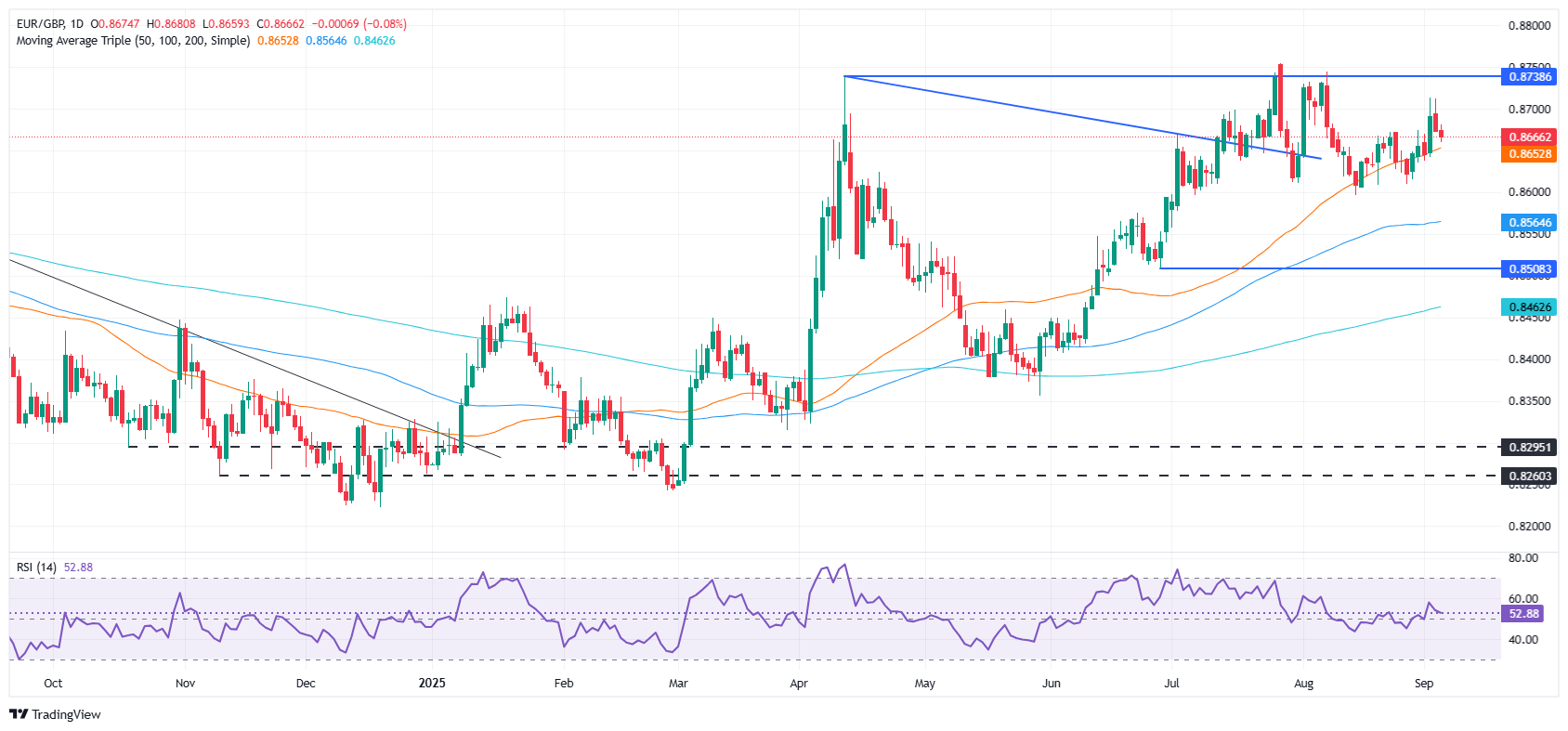EUR/GBP dips to 0.8660 as UK fiscal woes meet EZ inflation pressure
- EUR/GBP retreats from 0.8681 daily high, as market focus shifts to policy divergence.
- Eurozone retail sales disappoint, plunging 0.5% MoM in July, while annual growth slows sharply to 2.2%.
- ECB seen holding rates through 2025 as inflation stays high, while BoE signals further easing ahead.
The Euro retreats against the British Pound on Thursday, even though fears of an economic slowdown in the UK, hurts the prospects of the Sterling against rising inflation in the Eurozone. At the time of writing, the EUR/GBP trades at 0.8666 after hitting a daily high of 0.8681.
Euro retreats despite UK slowdown fears, with central bank divergence and fiscal uncertainty shaping near-term outlook
Economic data in the Eurozone (EZ) outweighed fears of fiscal difficulties surrounding the UK economy. Retail Sales in Europe were weaker than expected in July, plunged -0.5% MoM, below forecasts of -0.2%. In the twelve months to July, dupped from 3.5% to 2.2%, missing estimates for a 2.4% expansion.
On Wednesday, high inflation data in the EZ suggests that the European Central Bank (ECB) would not cut rates throughout the remainder of 2025. The Bank of England (BoE) Governor Andrew Bailey saying that interest rates would continue to fall. Hence, centra bank divergence favors further upside in the EUR/GBP cross-pair.
UK Finance Minister Rachel Reeves revealed that she will present the Autumn Budget on November 26. She is under pressure to keep finances on track.
Uncertainty about fiscal policy in the UK triggered a jump in yield of 30-year GILTs in the UK, which hit its highest level since 1998, as fixed income traders demanded a higher premium to park their money on UK’s debt.
Ahead this week, the economic docket in Europe will feature jobs data, and Gross Domestic Product (GDP) figures for Q2 2025. In the UK, market participants will eye the release of Retail Sales for July.
EUR/GBP Price Forecast: Technical outlook
After rallying from 0.8600 towards the 0.8700 figure, the EUR/GBP pullbacks as traders take a breather. Given the fundamental backdrop and price action remaining bullish, further upside is seen. The Relative Strength Index (RSI) is bullish but tilted to the downside.
That said, the EUR/GBP might be headed for a retracement. The first support would be 0.8652 the 20-day SMA, followed by the 50-day SMA at 0.8646 and 0.8600. Conversely, if traders push the pair past 0.8650, the next resistance would be the 0.8700 mark. If surpassed, the next stop would be August 7 high at 0.8743.

Euro FAQs
The Euro is the currency for the 19 European Union countries that belong to the Eurozone. It is the second most heavily traded currency in the world behind the US Dollar. In 2022, it accounted for 31% of all foreign exchange transactions, with an average daily turnover of over $2.2 trillion a day. EUR/USD is the most heavily traded currency pair in the world, accounting for an estimated 30% off all transactions, followed by EUR/JPY (4%), EUR/GBP (3%) and EUR/AUD (2%).
The European Central Bank (ECB) in Frankfurt, Germany, is the reserve bank for the Eurozone. The ECB sets interest rates and manages monetary policy. The ECB’s primary mandate is to maintain price stability, which means either controlling inflation or stimulating growth. Its primary tool is the raising or lowering of interest rates. Relatively high interest rates – or the expectation of higher rates – will usually benefit the Euro and vice versa. The ECB Governing Council makes monetary policy decisions at meetings held eight times a year. Decisions are made by heads of the Eurozone national banks and six permanent members, including the President of the ECB, Christine Lagarde.
Eurozone inflation data, measured by the Harmonized Index of Consumer Prices (HICP), is an important econometric for the Euro. If inflation rises more than expected, especially if above the ECB’s 2% target, it obliges the ECB to raise interest rates to bring it back under control. Relatively high interest rates compared to its counterparts will usually benefit the Euro, as it makes the region more attractive as a place for global investors to park their money.
Data releases gauge the health of the economy and can impact on the Euro. Indicators such as GDP, Manufacturing and Services PMIs, employment, and consumer sentiment surveys can all influence the direction of the single currency. A strong economy is good for the Euro. Not only does it attract more foreign investment but it may encourage the ECB to put up interest rates, which will directly strengthen the Euro. Otherwise, if economic data is weak, the Euro is likely to fall. Economic data for the four largest economies in the euro area (Germany, France, Italy and Spain) are especially significant, as they account for 75% of the Eurozone’s economy.
Another significant data release for the Euro is the Trade Balance. This indicator measures the difference between what a country earns from its exports and what it spends on imports over a given period. If a country produces highly sought after exports then its currency will gain in value purely from the extra demand created from foreign buyers seeking to purchase these goods. Therefore, a positive net Trade Balance strengthens a currency and vice versa for a negative balance.

